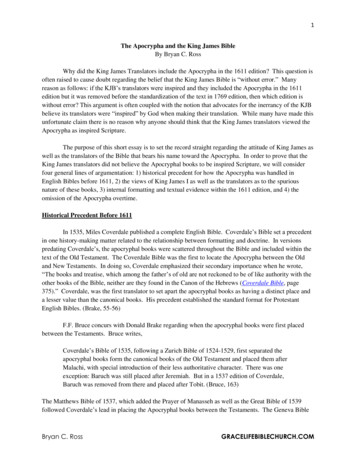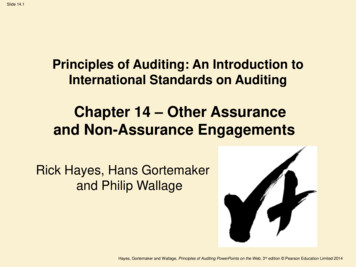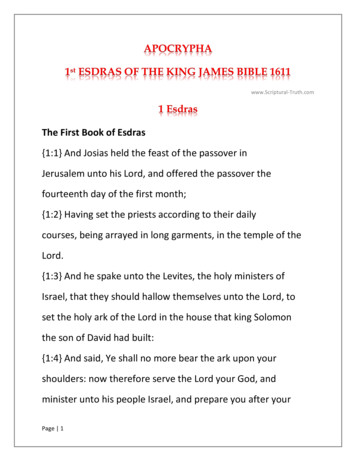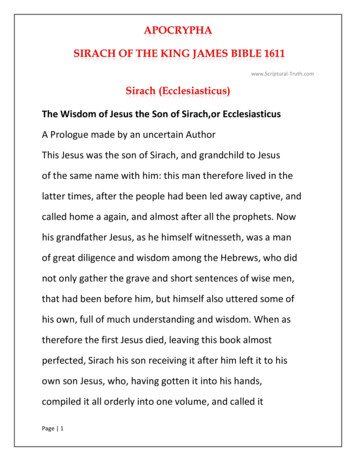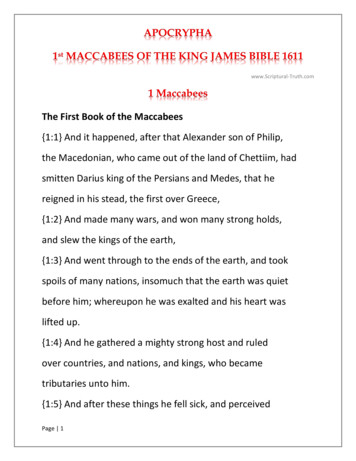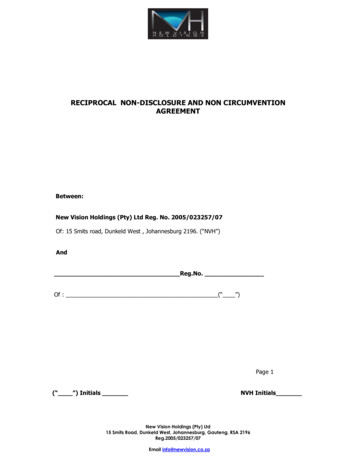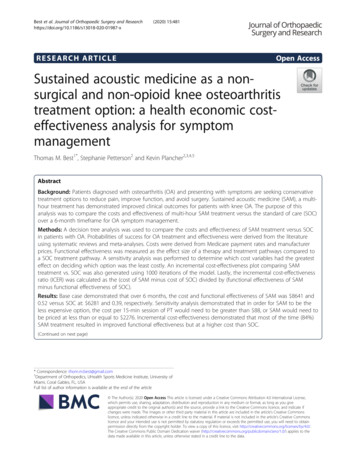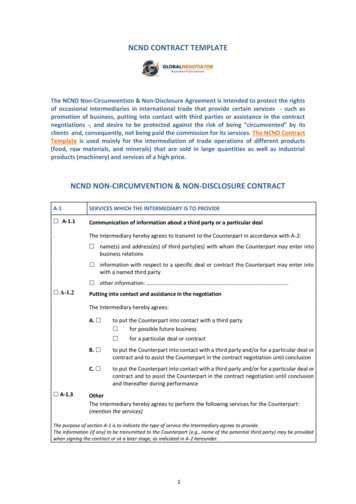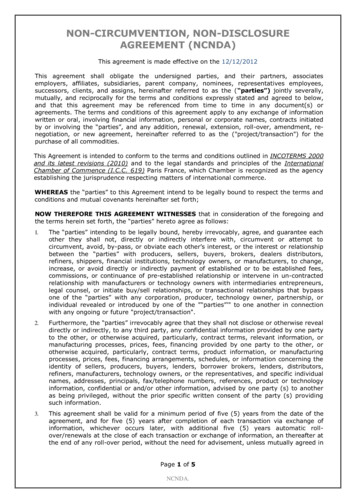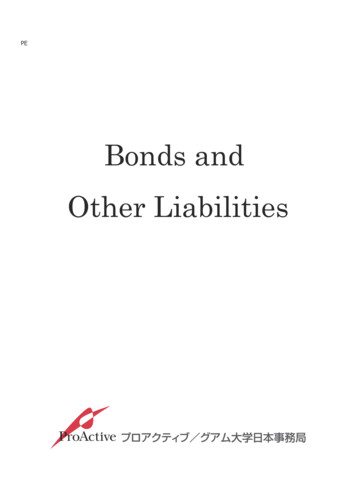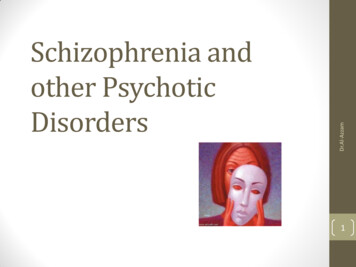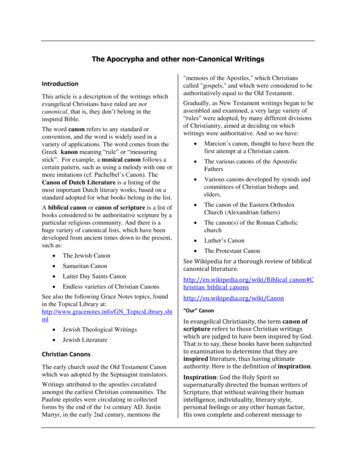
Transcription
The Apocrypha and other non-Canonical WritingsIntroductionThis article is a description of the writings whichevangelical Christians have ruled are notcanonical, that is, they don’t belong in theinspired Bible.The word canon refers to any standard orconvention, and the word is widely used in avariety of applications. The word comes from theGreek kanon meaning “rule” or “measuringstick”. For example, a musical canon follows acertain pattern, such as using a melody with one ormore imitations (cf. Pachelbel’s Canon). TheCanon of Dutch Literature is a listing of themost important Dutch literary works, based on astandard adopted for what books belong in the list.A biblical canon or canon of scripture is a list ofbooks considered to be authoritative scripture by aparticular religious community. And there is ahuge variety of canonical lists, which have beendeveloped from ancient times down to the present,such as: The Jewish Canon Samaritan Canon Latter Day Saints Canon Endless varieties of Christian CanonsSee also the following Grace Notes topics, foundin the Topical Library at:http://www.gracenotes.info/GN TopicsLibrary.shtml Jewish Theological Writings Jewish LiteratureChristian CanonsThe early church used the Old Testament Canonwhich was adopted by the Septuagint translators.Writings attributed to the apostles circulatedamongst the earliest Christian communities. ThePauline epistles were circulating in collectedforms by the end of the 1st century AD. JustinMartyr, in the early 2nd century, mentions the"memoirs of the Apostles," which Christianscalled "gospels," and which were considered to beauthoritatively equal to the Old Testament.Gradually, as New Testament writings began to beassembled and examined, a very large variety of“rules” were adopted, by many different divisionsof Christianity, aimed at deciding on whichwritings were authoritative. And so we have: Marcion’s canon, thought to have been thefirst attempt at a Christian canon. The various canons of the ApostolicFathers Various canons developed by synods andcommittees of Christian bishops andelders. The canon of the Eastern OrthodoxChurch (Alexandrian fathers) The canon(s) of the Roman Catholicchurch Luther’s Canon The Protestant CanonSee Wikipedia for a thorough review of biblicalcanonical literature.http://en.wikipedia.org/wiki/Biblical canon#Christian biblical canonshttp://en.wikipedia.org/wiki/Canon“Our” CanonIn evangelical Christianity, the term canon ofscripture refers to those Christian writingswhich are judged to have been inspired by God.That is to say, these books have been subjectedto examination to determine that they areinspired literature, thus having ultimateauthority. Here is the definition of inspiration.Inspiration: God the Holy Spirit sosupernaturally directed the human writers ofScripture, that without waiving their humanintelligence, individuality, literary style,personal feelings or any other human factor,His own complete and coherent message to
The Apocryphaman was recorded in perfect accuracy in theoriginal languages of Scripture, the very wordsbearing the authority of divine authorship.The task of determining that some writings areinspired, and the rules (canons) to be applied,is the subject of Bible seminary courses onBiblical Introduction. You can imagine thatthere is much controversy, doubt, anddiscussion about whether it is even possible tomake such a determination, let alone how to goabout it.Christian Bible teaching is based on theacceptance of the present organization of theOld Testament and New Testament canons, asfound in the Protestant Bibles (King James,New American Standard, etc.).The ApocryphaThe word Apocrypha means “hidden,” or“secret.” The term “Apocrypha” is usually appliedto a collection of books, from eleven to sixteen innumber, which appeared during the interimbetween the Old and New Testaments. Thesebooks have come down to us in more or less closeconnection with the canonical books of the Bible.These books have a strange history. Ecclesiasticalopinion in different periods has differed widely asto the value of this literature, and as to whetherany of these books are divinely inspired. The Jewsof the Dispersion in Egypt placed a high estimateupon these books and included them in the Greektranslation of the Old Testament, called theSeptuagint; but there were rejected from theHebrew canon by the Jews of Palestine.2gradually omitted from the modern editions of theProtestant Bibles, for the following reasons:1. They are never quoted by Jesus, and it isdoubtful if they were ever alluded to by theapostles.2. Most of the early Church Fathers regardedthem as non inspired.3. The books did not appear in the AncientHebrew canon.4. The inferior quality of most of the writings, ascompared with the canonical books, stampsthem as unworthy of a place in the sacredScriptures.The Old Testament ApocryphaCharacter of the BooksAuthorities differ as to the classification of thesebooks. The Epistle of Jeremiah is oftenincorporated in the Book of Baruch, and III and IVMaccabees are often omitted.Historic – I and II Maccabees; I EsdrasTraditional – Additions to Esther; Susanna; Songof the Three Holy Children; Bel and the Dragon;Judith; TobitProphetic – Baruch; Prayer of ManassesApocalyptic – II Esdras; IV Esdras in the LatinVulgateInstructive – Ecclesiasticus; The Wisdom ofSolomon (in style like the Proverbs)HISTORICAL APOCRYPHA 1 and 2 EsdrasThe Roman Catholic Church, in the Council ofTrent, 1546 AD, declared eleven of the books tobe canonical, and they appear in the modernCatholic editions of the Scriptures. 1 and 2 Maccabees Additions to Daniel Additions to EstherThe View of the Protestant Church The Epistle of Jeremy is adeuterocanonical (not part of theHebrew Bible) book of the OldTestament; supposedly written byJeremiah to the Jews who were about tobe carried away as captives to BabylonIt is commonly agreed that some of these bookscontain material of literary merit and historicalvalue. But the canonicity of all of the books of theApocrypha has been rejected, and they have been
The Apocryphaby Nebuchadnezzar. It is included inCatholic Bibles as the final chapter ofthe Book of Baruch. It is also included inOrthodox Bibles as a standalone book.The title of this work is misleading, forit is neither a letter nor was it writtenby the prophet Jeremiah. The Prayer of ManassesTHE LEGENDARY APOCRYPHA Book of Baruch Tobit JudithAPOCALYPTIC APOCRYPHA 4th Esdras as 2 EsdrasDIDACTIC APOCRYPHA The Wisdom of Solomon Sirach (Ecclesiasticus)During the early Christianity centuries, mostGreek and Latin church fathers, such asIranaeus, Tertullian, Clement of Alexandria, andCyprian, none of whom knew the Hebrewlanguage, quoted passages from the Apocryphalbooks as “scripture”, “divine scripture”, and“inspired”.Only occasionally did a Father make an effort tolearn the limits of the Hebrew Old Testamentcanon.In the 4th Century many Greek fathers came torecognize the difference between the books inthe Hebrew canon and the rest of the bookswhich some held to be scripture (Eusebius,Athanasius, Cyril of Jerusalem, Gregory ofNazianzus, Amphilochious, Epiphanius).The Latin (Roman) church, at the council ofHippo (393 AD), and the council of Carthage(419 AD), authorized the use of apocryphalbooks as scripture.In the 14th century, John Wycliffe produced thefirst English version of the Bible. This includedall the Apocrypha except II Esdras. However, he3stated that these books were not authoritativefor doctrine.The first edition of the Swiss-German Bible, orthe church of Zurich, 1527-1529, is written insix volumes, the fifth volume being theApocrypha. They were described as “bookswhich are not reckoned as Biblical by theancients nor found among the Hebrews.”The Council of Trent, in 1546, from theviewpoint of the Roman Catholic church, gavethe first “infallible” approval of the Apocrypha.The Council also pronounced a decree ofanathema on any who refused to acknowledgethese writings as canonical (inspired). The listdid not include, however, the Prayer ofManasses or the books of I and II EsdrasAt the synod of Jerusalem in 1672, the books ofWisdom, Judith, Tobit, Bel and the Dragon,Susanna, Maccabees, and Ecclesiasticus weredesignated as canonical.In England, the Protestants were united inrejecting the Apocryphal books as canonical,but there were various differences as to howthe books could be used. Some thought theywould be valuable as sermons, others areresources for research.The Puritans published a Bible that did notcontain the Apocrypha, their having anaversion to any human book that was not in theHebrew or Greek canon.The earliest version of the English Bible whichexcluded the Apocrypha were some GenevaBibles printed in 1599 in Belgium.George Abbot, the Archbishop of Canterbury,and one of the translators of the King JamesBible, in 1615 gave public notice that no copy ofthe Bible was to be bound or sold which did notcontain the Apocrypha. However, there was agrowing demand for non-Apocrypha Bibles,and copies began showing up without it in theyears from 1616 to 1633.
The Apocrypha4Reasons for Rejecting the Old Testament ApocryphaThe New Testament Apocrypha1. It is universally admitted that the OldTestament apocryphal books never had aplace in the Hebrew canon.Reasons for the Origin of the New TestamentApocrypha2. They were never quoted in the NewTestament, either by Christ or His apostles.1. A desire for more details and knowledgeabout Christ than were communicated bythe apostles and evangelists.3. Josephus excludes them, he limits thenumber of books to 22, which he lists.4. Philo of Alexandria quote frequently fromthe Old Testament, but never mentionedthe Apocryphal books, and never quotedthem.5. They are not found in any catalog ofcanonical books made during the first fourcenturies.6. Jerome declared for the strict Hebrewcanon and rejected the authority of theentire Apocrypha.7. None of the writers of the Apocrypha claimdivine inspiration; some of them even denythey were inspired.8. The books contain many historical,chronological, and geographical errors,distortions of Old Testament narratives,and contradict the Bible, secular history,and themselves.2. Desire for more details in the Gospels,especially with regard to Christ’s birth,childhood, life of Mary and Joseph, etc.3. Publication of opinions about doctrineissues, such as humanity and deity ofChrist, were prompted by authors’ desiresto publish their views.4. Originated to fill up the supposed lacks andgaps in the canonical writings.Categories of the New Testament Apocrypha The apocryphal gospels – non-canonicalbut not necessarily spurious. The apocryphal epistles – non-canonicaland pseudepigraphical (see below on thePseudepigrapha) The apocryphal apocalypses – noncanonical and pseudepigraphicalListing of New Testament Apocryphal books9. No prophets were connected with theApocrypha. Teachings of the Twelve Apostles Epistle of Barnabas10. They teach doctrines and practices whichare directly opposed to the canon ofScripture. First and Second Epistles of Clement Shepherd of Hermas Apocalypse of Peter Acts of Paul, including Paul and Thecla Epistle of Polycarp to the Philippians12. The Apocrypha was not permitted to beread for instruction by any organization orgroup, until the Roman Catholic Council ofTrent did so in 1546, and then by a smallmajority. Seven Epistles of Ignatius Gospel of the pseudo-Matthew Protevangelium of James Gospel of the Nativity of Mary13. While there are Targums for the Hebrewcanon, there are no Targums for theApocrypha. Gospel of Nicodemus Gospel of the Savior’s Infancy11. The books were written much later thanthe Old Testament and after the Hebrewcanon was closed in about 425 BC.
The Apocrypha5 History of Joseph the Carpenter The Apocalypse of Elijah The Clementine Homilies – work of fictionattributed to Clement of Rome, datedapproximately at the end of the 2nd centuryor beginning of the 3rd. The Apocalypse of Zephaniah The apocalypse of Esdras The Sibylline Oracles The Epistle from Laodicea – possiblereference to it in Colossians 4:16,apparently a forgery The Lost Epistles to the Corinthians – from1 Corinthians 5:9, date from about 200 AD. The Epistle to the Alexandrians, lost today,mentioned in the Muratorian Fragment Letters of Paul to Seneca – in Latin, sixletters of Paul and eight of Seneca.The Pseudepigraphical WritingsPseudepigrapha are falsely attributed works,texts whose claimed authorship is representedby a separate author; or a work, "whose realauthor attributed it to a figure of the past." Theword "pseudepigrapha" is fromthe Greek: ψευδής, pseudes, "false"and ἐπιγραφή, epigraphē, "name" or"inscription" or "ascription"; thus when takentogether it means "false superscription or title".(Wikipedia)In the Bible context, the Pseudepigrapha arewritings which claim Biblical authorship buthave never been accepted as either canonical orapocryphal. There are pseudepigraphicalwritings for both the Old and New Testaments.LEGENDARY BOOKS The Testament of Adam The Book of the Jubilees The Testaments of Abraham, Isaac, andJacob The Apocalypse of Abraham The Testament of the Twelve Patriarchs Life of Asenath, Joseph’s wife Testament of Job Testament of Solomon The Book of Noah Penitence of Jannes and JambresPOETICAL BOOKS Psalms of Solomon Eighteen psalms in Greek Additions to the PsalterDIDACTIC (TEACHING) BOOKS Magical Books of Moses The Story of AchiacharusThe Old Testament PseudepigraphaThe New Testament PseudepigraphaAPOCALYPTIC BOOKSTHE PSEUDO-GOSPELS Books of Enoch Gospel of Andrew Secrets of Enoch Gospel of Bartholomew The Apocalypse of Baruch Gospel of Barnabas The Rest of the Words of Baruch Gospel of Matthias The Assumption of Moses Gospel of Thomas A Revelation of Moses Gospel of Peter The Prophesy of Isaiah Gospel of Philip
The ApocryphaTHE PSEUDO-ACTS6THE EPISTLE OF PAUL TO THE LAODICEANS The Acts of JohnThis stands in a category by itself The Acts of PaulTHE PSEUDO-APOCALYPTIC BOOKS The Acts of Peter The Apocalypse of Peter The Acts of Andrew The Apocalypse of Paul The Acts of Thomas The Apocalypse of Thomas The Acts of Matthias The Apocalypse of John the Theologian The Acts of Philip The Acts of Thaddaeus
The earliest version of the English Bible which excluded the Apocrypha were some Geneva Bibles printed in 1599 in Belgium. George Abbot, the Archbishop of Canterbury, and one of the translators of the King James Bible, in 1615 gave public notice that no copy of the Bible was to be bound
